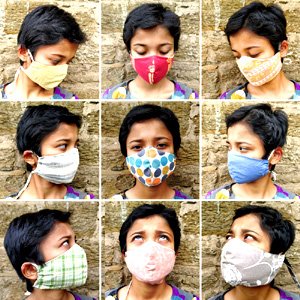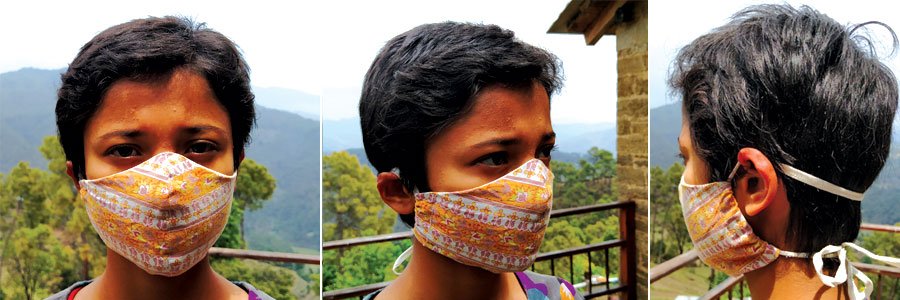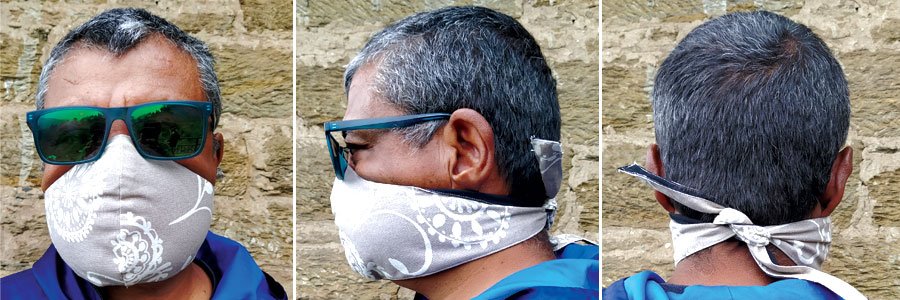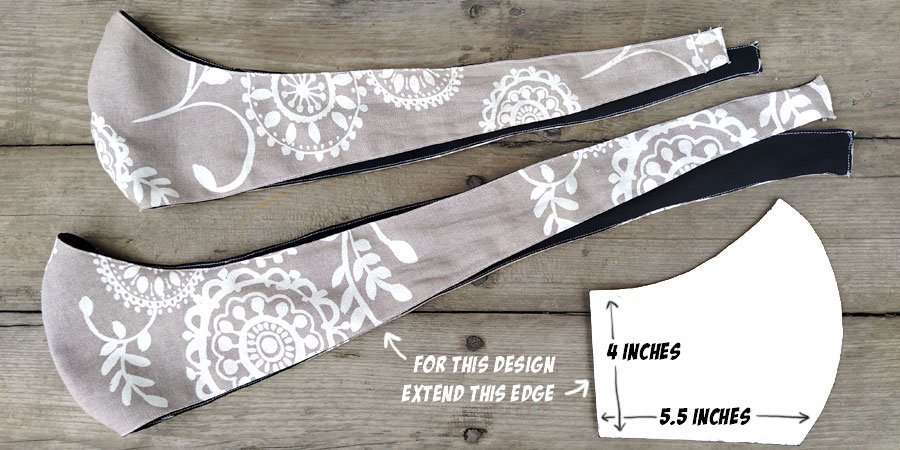Anatomy of an efficient face mask
If Covid19 is here to stay, we would need a safety product whose manufacturing is decentralised, raw material available and the cost affordable. This article explores various factors that make a cloth mask suitable and effective.
The internet is flooded with lockdown pictures – empty streets, wild animals in urban spaces and people with masks – many of them with their nose exposed. I can think of five possible reasons for that. One reason could be to ease the pressure on the ears. Other could be that when the masked person opens the mouth wide, for whatever reasons, the mask slides down due the chin and exposes the nose. Third could be that they are doing it just for compliance reasons and do not truly believe that masks can make a difference. Fourth may be miscommunication with regards to the role of nose in transmission of disease. And last but not the least, to get pictures clicked because charity seems to need a face.
Even where the nose is not exposed, the mask is awkwardly positioned. What this means is that either people are not serious about the mask (communication issue) or the mask is not functioning as it should (design issue).
I have already written three articles on need for masks and related issues –
- Covid19 and cloth masks – How masks can help reduce transmission of disease through droplets and surface contamination
- Covid19 and open windows – On role of bio-aerosols
- Herd needs masks more than unnecessary medical research – On masks, medical research and lockdowns
In this article we will explore the design issues with regards to cloth mask and illustrate the anatomy of an efficient cloth mask.
The need for cloth masks

If Covid19 is here to stay, we would need a safety product whose manufacturing is decentralised, raw material availability is not an issue and the cost is affordable.
Filters like N95 are already in short supply even for healthcare personnel so let us keep it out of this discussion and only consider the possibility of using surgical masks instead of cloth masks. It is believed that surgical masks perform much better than cloth masks though this may not be entirely true.
Though a surgical mask does not cost much, it is not designed for reuse due to which the cumulative cost goes up. Its widespread use would lead to supply chain problems at raw material sourcing as well as retail end.
Another important concern is the environmental impact. We will end up with a huge pile of used surgical masks which will need proper disposal. Manual handling of such waste would put waste handlers at risk.
Functions of a good face mask
The face mask is recommended not only to avoid an infection but also avoid disease transmission by asymptomatic patients. Many asymptomatic patients may, unknowingly, transmit the disease. Many of them may recover after mild symptoms, without even realising that they acted as carriers.

A good face mask should provide unrestricted breathing while effectively filtering droplets and bio aerosols. With regards to filtering efficiency, we know that a cloth mask cannot compete with masks like N95. But we do not need such efficiency. N95 seems like an overdesign for day-to-day use. Its primary use is in hospital conditions where healthcare personnel are at great risk due to frequency and extent of exposure.
The filtering efficiency of cloth masks depend on the fabric used. In order to ensure that the choice of material has some scientific basis, we can refer to any research which deals with viruses that have similar physical properties as that of SARS-CoV2. The physical properties of the virus, and not the RNA, would affect filtration.
It is important that the mask fits well. A mask that is not well sealed, even with 100% filtering efficiency, will decrease filtering efficiency by over 50%. Higher the efficiency, higher would be impact of ‘leakage’ as air will find the path of least resistance.
A well-fitting mask should also ensure that it does not hinder day to day functioning of the wearer. Wearer should be able to work with ease, without feeling the burden of this ‘extra’ element. It is essential that the mask should not need regular adjustments.
For the mask to be reusable, it should be easily washable and should dry easily. A simple soap wash every night should make it ready for the next day. Fabric choice should ensure that the mask does not react adversely to such regular washing, even though the wash is not rigorous.
Worthy fabric for an efficient cloth mask
We have to use a cloth mask unless we find some viable alternative. To choose ideal material, we need to explore various studies about filtering efficiencies. A common thread that binds most studies is that filtration gets better with multiple layers and with fabric of tighter weave (threads per inch).
Studies have revealed that the virus we are dealing with has polydisperse aerosols (where particle size is not constant) with size variation of 0.25 to 1.0 micron. It is widely accepted that cloth marks are fairly efficient when dealing with droplets hence the efficiency of a fabric to filter aerosols is our primary design concern.
After exploring various studies, I found the study published on the website of American Chemical Society to be the most interesting. Its findings sound logical.
The ACS publication titled ‘Aerosol Filtration Efficiency of Common Fabrics Used in Respiratory Cloth Masks’ concludes the following (Units used have been changed to ensure consistency. SARS-CoV2 aerosol size varies from 0.25 to 1.0 micron) –
- Cotton, natural silk, and chiffon can provide good protection, typically above 50% in the entire 0.01 micron to 6.0 micron range, provided they have a tight weave.
- Cotton with tighter weaves provides better filtration efficiency.
- It is highly likely that tangled fibrous nature of the fabric aids performance at small particle sizes.
- Materials such as silk and chiffon are particularly effective (considering their sheerness) at excluding particles less that 0.1 micron probably due to electrostatic effects.
- A four-layer silk (used, for instance, as a scarf) was effective with an average efficiency of over 85% across the 0.01 micron to 6 micron particle size range.
- Hybrid combinations of cloths such as high threads-per-inch cotton along with silk, chiffon, or flannel can provide broad filtration coverage across both droplets and aerosols, likely due to the combined effects of electrostatic and physical filtering.
- Openings and gaps, such as those between the mask edge and the facial contours, can degrade efficiencies by 50% or more.
Even if these results are partially true, we are still talking about a fairly good filtration for non-hospital environment. If everyone wears a mask then the combined efficiency would increase due to lesser contamination of the environment. If one avoids non-ventilated and crowded spaces, and follows social distancing measures, these efficiencies should serve us well.
The key highlights of the filter efficiency (%) of various fabrics are presented below. For ease of understanding, the percentage error has been removed and units made consistent. If you are technically inclined, please refer the ACS study for more details.
| Sample /Fabric | Less than 0.03 micron | More than 0.03 micron |
| N95 | 85 | 99 |
| N95 (with gap) | 34 | 12 |
| surgical mask | 76 | 99.6 |
| surgical mask (with gap) | 50 | 44 |
| Cotton Quilt | 96 | 96.1 |
| Flannel | 57 | 44 |
| Cotton (600 TPI), 1 layer | 79 | 98.4 |
| Cotton (600 TPI), 2 layers | 82 | 99.5 |
| Chiffon, 1 layer | 67 | 73 |
| Chiffon, 2 layers | 83 | 90 |
| Natural silk, 1 layer | 54 | 56 |
| Natural silk, 2 layers | 54 | 56 |
| Natural silk, 3 layers | 65 | 65 |
| Natural silk, 4 layers | 86 | 88 |
| Hybrid : cotton + chiffon | 97 | 99.2 |
| Hybrid: cotton + silk | 94 | 98.5 |
| Hybrid: cotton + flannel | 95 | 96 |
I checked alternate sources for information. Smart air filters has conducted tests and shared details in the article – Can DIY Masks Protect Us from Coronavirus? Their test for aerosols reveal 60% efficiency of mask made from tea cloth, as against surgical masks that yielded 77% efficiency. They also found that efficiency of cloth mask improved by 5% after 3 hours of use while there was negligible increase in case of surgical masks and 1% decrease in case of N95 masks. These findings seem to support the findings of the American Chemical Society study
Design of the cloth mask
Let us start with the fit. In my opinion, one of the main reasons for a bad fit is the elastic chord around the ears that holds the mask. Even medical professionals who use masks regularly are finding it hard to wear them for long durations. The idea of elastic chords is based on the assumption of a global fit without realising that the pressure on the ear will change from person to person. In the wake of Covid19 we started making cloth masks but inherited the faulty legacy of elastic chords.
A non-elastic chord would perform far better than an elastic one, when it comes to sustained usage. Under ordinary circumstances, medical personnel do not wear the mask whole day long. In scenarios where masks are needed, surgery for instance, they change masks to attend different patients. Earlier, they too wore cloth masks sans elastic chords. I think elastic chords came in when masks became consumable, probably due to general lethargy towards wash/sterilisation of re-usable items.
If you want to make a cloth mask, designed like a surgical mask, make it at least two layered, possibly with material combinations listed in the table above. Size of the cloth would depend on the face of a person. One can start with a cloth piece of 10 inches by 6 inches for each layer. One can increase or decrease this size based on need. If you are making them for others, make them in at least 3 sizes (+/- 1cms) – large, medium and small. There are many DIY pages and videos that provide how-to details. Centre of Disease Control has also published information about making masks. Choose a design based on availability of tools. Do not worry if you do not have a sewing machine. One can always hand stitch. For enhanced aesthetics, one can opt for embroidery stiches.
Almost all the mask tutorials recommend elastic chords. Simply replace it with non-elastic chord. You can even stitch these chords. But in case you still want to use elastic chord then, in order to reduce ear pain from prolonged use, tie the elastic loops together with a non-elastic chord of desired length.
When a Canadian boy scout Quinn Callander found about this problem, he designed and fabricated surgical mask straps to gift it to local hospitals. In the absence of 3D printer, one can also make such straps manually, using plastic salvages from old containers. And if you have access to 3D printer then you can download files made available by Quinn at Makerbot Thingiverse. As per the information provided on this page, the strap has been reviewed and approved for use in a clinical setting by the NIH (US National Institute of Health)

After making and using the rectangular masks, we found that they are not very stable. Even when tied well, they tend to slide down as one talks or laughs. Looking for alternate design options led us to this design which seems to work well

When using non-elastic chords, tying the knots can be troublesome so we used a single continuous chord. One has to just ensure that the chord is anchored to the mask at one point, so that tying becomes convenient.
Me and my daughter, Kritika, took reference from various sites, and stitched variety of curved masks to explore which fits well. We settled for a design and Kritika fine-tuned the chin curve to get better fit and also worked on three different size options. Further exploration led us to this design option. It fits well and is user-friendly


Though this design consumes more fabric, its usability justifies the consumption. This mask will not only serve well during Covid times but can also be used while visiting polluted cities, riding a bike, during winters, or when any other form of flu is prevalent in the neighbourhood.
Whatever pattern we opt for, there is a high chance that there will be a leakage from the nose ridge area. That gap can be plugged by using some sort of nose clip or inserting a semi-flexible wire in the mask so that it can be adjusted to the nose contour.
The stitching details of these types of masks are available online. You can check DIY Cloth Face Mask for step by step guidance on how to stitch. Base your choice of fabric on the information provided in this article.
Does this design guarantee protection?
Well, as of now, nothing can be said for sure. Even the most basic data about the disease is missing. So, till the time we have concrete information about Covid19 transmission or someone starts making highly efficient, affordable, environment friendly filters that can be made available to everyone, we will have to work along these lines. New researches, in coming days, may provide us credible inputs for refinement of this approach or coming up with alternate design approaches.
To reiterate, masks cannot be our sole defence against Covid19. To ensure protection, one has to avoid closed spaces with improper ventilation, adhere to basic social distancing guidelines and maintain hygienic practices like hand washing.
There are too many videos providing quick-fix solutions. I would not recommend wasting time on such ‘jugaad’ items. Most of them will do no good. But in case you are in an emergency situation and have nothing but a handkerchief or a piece of cloth available, then go for this easy solution provided by a fellow designer Deepak Pathania.















There is one more reason of people wearing masks with nose exposed..ive personally questioned them as to why there nose was not covered..the teply was that masks are meant for covering mouth so tgat spit cannot travel..they had no idea that droplets are also expelled through the nose and also inhaled through it..they do not have the basic idea about how a mask works..people need mask literacy..you are doing a good job bro.
thanks. realized that after your comment. have incorporated that in the main text